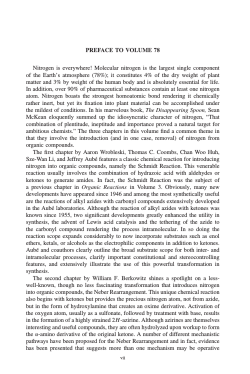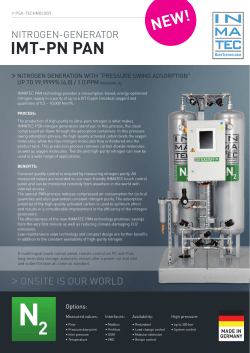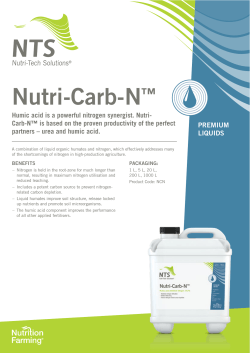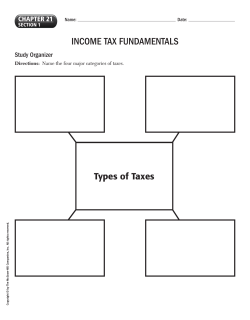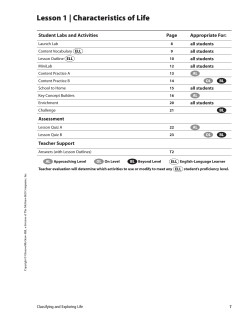
Ecology Study Guide
Name Date Class CHAPTER 2 Study Guide Section 1: Organisms and Their Relationships In your textbook, read about ecology. Read each statement. If it describes the study of ecology, write yes. If not, write no. 1. Ecology is the study of interactions among organisms. 2. Ecologists mainly study green plants. 3. Most experiments in ecology are quick and done in a lab. 4. Models help ecologists control the many variables in their studies. In your textbook, read about the biosphere and levels of organization. Match the definition in Column A with the term in Column B. Copyright © Glencoe/McGraw-Hill, a division of The McGraw-Hill Companies, Inc. Column A Column B 5. made up of individual organisms of the same species A. abiotic factors 6. all nonliving things in an environment B. biosphere 7. made up of the organisms and nonliving things in an area C. biotic factors 8. portion of Earth that supports life D. ecosystem 9. all living organisms in an environment E. population In your textbook, read about the ecosystem interactions and community interactions. Complete the table by checking the correct column(s) for each interaction. Interaction Involves Abiotic Factors Involves Biotic Factors 10. Commensalism 11. Competition 12. Habitat 13. Mutualism 14. Niche 15. Predation Unit 1 CHAPTER 2 Principles of Ecology 49 Name Date Class CHAPTER 2 Study Guide Section 2: Flow of Energy in an Ecosystem In your textbook, read about autotrophs and heterotrophs. Match the definition in Column A with the term in Column B. Column A Column B 1. get energy by eating other organisms A. autotrophs 2. eat both plants and animals B. carnivores 3. eat only animals C. detritivores 4. collect energy to produce their own food D. herbivores 5. eat only plants E. heterotrophs 6. eat or break down dead things F. omnivores In your textbook, read about models of energy flow. Label the food chain below to identify each trophic level. Use these choices: carnivore GRASS herbivore → 7. omnivore GRASSHOPPER 8. → producer RACCOON 9. → COYOTE 10. Copyright © Glencoe/McGraw-Hill, a division of The McGraw-Hill Companies, Inc. Label the ecological pyramid. Use these choices: primary consumers producers secondary consumers 11. 12. 13. Respond to each statement. 14. Recall the name for the total amount of living matter in each trophic level of an ecological pyramid. 15. Explain why an ecological pyramid is smaller at the top than at the bottom. 50 Principles of Ecology CHAPTER 2 Unit 1 Name Date Class CHAPTER 2 Study Guide Section 3: Cycling of Matter In your textbook, read about the water cycle. Number the steps of the water cycle in the order in which they occur. Begin with the collection of water in lakes or oceans. 1. Groundwater and runoff from land surfaces flow into rivers, lakes, and oceans. 2. Water returns to Earth as rain or snow through the process of precipitation. 3. Through evaporation, water changes from a liquid to a gas that becomes part of the air. 4. Through condensation, water in the air changes from a gas to tiny droplets of liquid. In your textbook, read about the carbon and oxygen cycles. Refer to the illustration. Use each of the terms below only once to complete the passage. atmosphere living organisms carbon photosynthesis water "URNINGOF FOSSILFUELS 4HE#ARBON#YCLE Copyright © Glencoe/McGraw-Hill, a division of The McGraw-Hill Companies, Inc. cycles respiration #/IN ATMOSPHERE 0HOTOSYNTHESIS 0RECIPITATION )NDUSTRYAND AGRICULTURE 2ESPIRATION $EATHDECOMPOSITION 0HOTOSYNTHESIS #/DISSOLVEDINWATER #ARBONCOMPOUNDS CONVERTEDTOFOSSILFUELS #ALCIUMCARBONATESIN ROCKSANDSHELLS $EATHDECOMPOSITION (5) It (6) is a part of all organic compounds, which make up living things. through the environment due to the flow of energy in ecosystems. The carbon cycle is made of several processes, including (7) (8) . During these processes, carbon moves between its major reservoirs. These major reservoirs include the (9) (10) Unit 1 and , the , and (11) . CHAPTER 2 Principles of Ecology 51 Study Guide, Section 3: Cycling of Matter continued In your textbook, read about the nitrogen cycle. Use each of the terms below only once to complete the passage. ammonia denitrification atmosphere nitrogen fixation consumers plants decay proteins decomposers urinate Nitrogen is a nutrient that organisms need to produce (12) . Plants and animals cannot use the nitrogen that makes up a large percentage of the . The nitrogen is captured and converted into a form that is usable (13) . Nitrogen enters the food web when by plants in a process called (14) absorb nitrogen compounds from the soil and use them to make (15) get nitrogen by eating plants or animals that contain proteins. (16) or when nitrogen. Nitrogen is returned to the soil when animals (17) . (19) organisms die and (18) break . This compound is down organic matter found in organisms into (20) changed by organisms in the soil into other nitrogen compounds that can be used by plants. Finally, some soil bacteria convert nitrogen compounds into nitrogen gas, which returns to the atmosphere in a process called (21) . In your textbook, read about the phosphorus cycle. Label the diagram of the phosphorus cycle. Use these choices: new rock short-term cycle soil and groundwater Plants and animals 22. Copyright © Glencoe/McGraw-Hill, a division of The McGraw-Hill Companies, Inc. long-term cycle Mountainbuilding 23. 24. 22. Oceans, lakes, ponds, rivers Decomposers Sediments 25. 23. 52 Principles of Ecology CHAPTER 2 24. 25. Unit 1
© Copyright 2025

